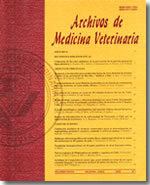Prostatic acid phosphatase in serum and semen of dogs
Main Article Content
Abstract
The incidence of prostatic malignancy has increased the use of tissue markers to detect cancer. Tissue specific antigens or differentiation antigens are found on the surface of normal cells. Clinically, these antigens are important to diagnose alterations in the tissues and for immunotherapy. The objective of the present study was to evaluate the prostatic acid phosphatase concentration in blood and seminal plasma of intact and healthy dogs at different ages. The evaluation was carried out by spectrophotometer, using a commercial kit. The prostatic acid phosphatase (PAP) levels did not differ according to the age and did not correlate with age or prostatic dimensions verified by ultrasonography. The PAP concentration values varied greatly within each group. However, more studies are necessary to evaluate the role of prostatic acid phosphatase in the canine prostate and its importance as a diagnostic test for prostate disorders.

